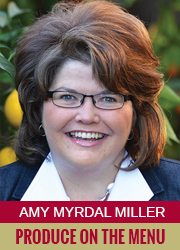 This is the first of a three-part series looking at the unique challenges both small and large foodservice operations face in getting product onto menus.
This is the first of a three-part series looking at the unique challenges both small and large foodservice operations face in getting product onto menus.
When I started working at The Culinary Institute of America in 2007, I learned that if I were going to get any cooperation or respect from the chefs, I needed to quickly learn their language. As a registered dietitian, I was used to talking about nutrition and numbers. When working with chefs, I realized I’d have more power talking about food and flavor.
If you want to sell more produce to chefs, here are my recommendations.
Familiarity
First, you need to familiarize yourself with the chef’s menu. Go to the website and download the menu. If the restaurant doesn’t have a website, go to the restaurant and pick up a copy of the menu. If they won’t let you take a copy with you, take a few photos. A chef will be more likely to listen to your sales pitch if you have ideas that work with his or her current operation.
Where is produce currently used on the menu, and where could more produce be used on the menu? Are the salads using just one type of lettuce? Are the side dishes limited to just a few vegetables? Is there an opportunity to feature more fruit on the dessert or beverage menu? Would the menu benefit from a seasonal or limited-time offer (LTO) to generate some excitement?
Flavor
Second, when talking about your produce, talk about the flavor, not the appearance. Perfect peaches don’t matter in a restaurant kitchen. They’ll be quickly transformed into something. Unless you’re selling bananas to an operation like Starbucks that will feature whole bananas, don’t bother selling on perfect looks.
While foodservice and retail have some things in common, foodservice has many unique attributes. The more you appreciate this, the better you’ll be in moving more produce onto restaurant and foodservice menus.
Form
Most restaurants strive to keep food costs below 35 percent, so price is always going to be an issue. But keep in mind, restaurants also have fixed overhead and variable labor costs, which—for operations with minimum wage team members—is a big issue. With minimum wage increases in states such as California, reducing food costs is an option for controlling expenses. But if you can provide produce with value-added benefits that reduce some labor costs, you’re selling something of interest to a restaurant. Also, keep in mind many restaurants have minimally skilled labor. There are many produce products that are difficult to work with (e.g., peeling and cutting squash, cutting and pitting avocados), and paying a premium for value-added fresh-cut is preferable to paying for workers’ compensation claims for kitchen injuries.
Features And Functions
Another opportunity for capturing a chef’s attention is to talk about how many ways your produce item can be featured on the menu. Restaurants with limited refrigerated storage need produce items that can function in many ways on the menu.
Promotion
Can your marketing and PR team help with promotions for the chef or restaurant? An LTO can turn into a full-time menu offering if promotions drive sales beyond expectations. If your company is willing to invest in helping the chef and restaurant promote a new menu item, you may get much more than a one-time sale.
Support
Do you have a training team that can provide valuable training for a chef or restaurant? Produce storage, and its effect0 on quality and shelf-life, is a big issue for controlling food costs in a restaurant operation. What can you do to help a restaurant team better manage its produce handling and storage?
These tips are just scratching the surface of what you can do to better serve your foodservice clients. While foodservice and retail have some things in common, foodservice has many unique attributes. The more you appreciate this, the better you’ll be in moving more produce onto restaurant and foodservice menus.
Amy Myrdal Miller, MS, RDN, FAND is a farmer’s daughter from North
Dakota, award-winning dietitian, culinary nutrition expert, and founder and president of Farmer’s Daughter Consulting, Inc. Learn more about her business at www.farmersdaughterconsulting.com. Follow her insights on food and flavor issues on Twitter @AmyMyrdalMiller.




